Purple Heart Plant
- November 6, 2023
- 0 comment
The Purple Heart plant, scientifically known as Tradescantia pallida or Setcreasea pallida, is a popular and striking houseplant that hails from Mexico. This hardy perennial is celebrated for its distinctive foliage, which features elongated, lance-shaped leaves with a rich and vibrant purple hue.
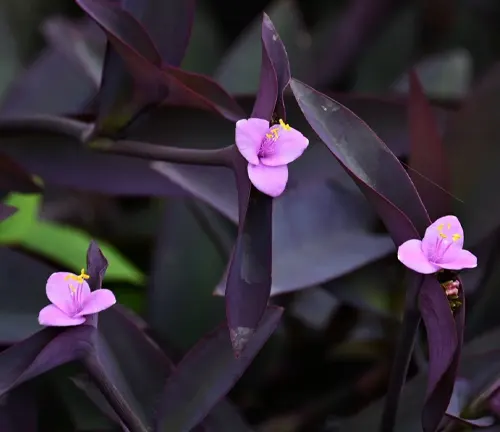
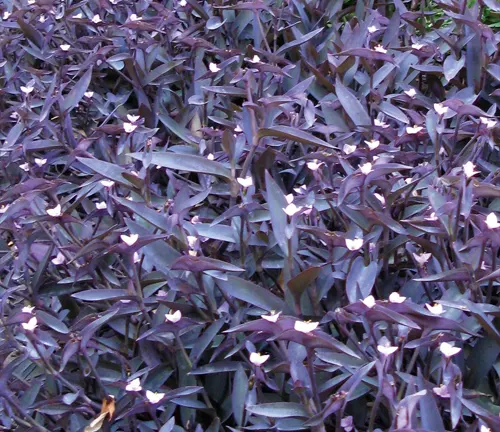
Its resilient nature makes it a favorite among indoor gardeners, as it can thrive in a wide range of conditions, from bright indirect light to low-light environments. The Purple Heart plant is known for its easy propagation, making it a great choice for both beginners and experienced plant enthusiasts.
It not only adds a touch of elegance and color to your home but also offers a natural air-purifying quality. Whether cascading from hanging baskets or adorning a tabletop, this eye-catching plant is a captivating addition to any indoor garden.
| Characteristics | Description |
| Botanical Name | Tradescantia pallida or Setcreasea pallida |
| Common Names | Purple Heart Plant, Purple Queen, Wandering Jew |
| Plant Type | Perennial, Herbaceous |
| Foliage | Lance-shaped, purple leaves |
| Growth Habit | Trailing or spreading |
| Mature Height | 6-12 inches (15-30 cm) |
| Sunlight | Bright indirect light to partial shade |
| Watering | Allow the top inch of soil to dry between waterings |
| Soil Type | Well-draining, loamy soil |
| Temperature Range | 60-85°F (15-29°C) |
| Humidity | Average indoor humidity, but tolerant of dry conditions |
| Fertilization | Monthly during the growing season (spring and summer) |
| Propagation | Easily propagated from stem cuttings |
| Toxicity | Mildly toxic to pets if ingested |
| Pest and Disease Resistance | Generally resistant to pests and diseases |
| Maintenance | Low maintenance, occasional pruning to control growth |
| Uses | Indoor decoration, hanging baskets, ground cover in outdoor gardens |
| Special Features | Air-purifying qualities, attractive purple foliage |
Botanical Beauty of “Purple Heart Plant”
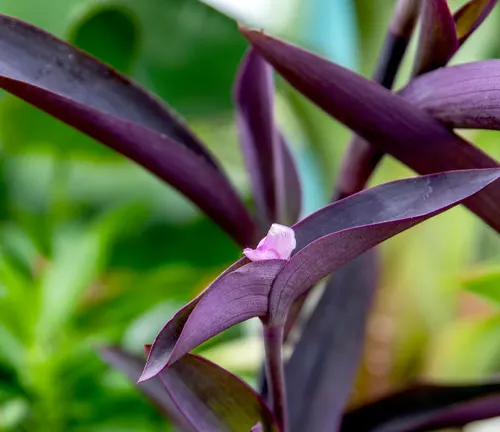
The “Purple Heart plant,” scientifically known as Tradescantia pallida or Setcreasea pallida, is a botanical wonder celebrated for its stunning appearance. This elegant perennial hails from Mexico and boasts elongated, lance-shaped leaves that are nothing short of a botanical masterpiece. What sets this plant apart is its mesmerizing purple foliage, which creates a visual spectacle wherever it grows. In this article, we’ll explore the botanical beauty of the Purple Heart plant, delving into its aesthetic allure and why it’s a favorite among plant enthusiasts.
Woodland Elegance
The Purple Heart plant exudes an aura of woodland elegance. Its cascading or spreading growth habit, combined with those regal purple leaves, evokes a sense of lush forest floors. Whether in hanging baskets, window sills, or as ground cover, this plant lends a touch of natural grace to any setting. Its versatility in both indoor and outdoor environments makes it a favorite choice for gardeners looking to infuse their spaces with a touch of organic charm.
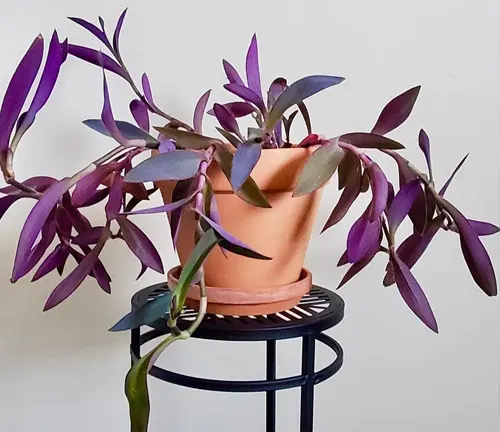
Ecological Importance
While the Purple Heart plant is primarily valued for its aesthetics, it also carries ecological importance. Its lush growth can provide habitat and shelter for various small creatures. In its natural habitat, it plays a role in supporting local biodiversity, contributing to the delicate balance of ecosystems. When cultivated, it can still be part of a mini-ecosystem by providing a comfortable home for beneficial insects like spiders.
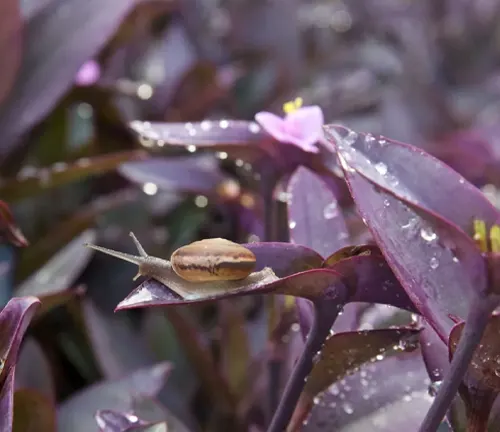
Cultivation and Conservation
Cultivating the Purple Heart plant is as rewarding as it is easy. It thrives in a variety of conditions, making it accessible to both novice and experienced gardeners. This plant’s hardiness extends to its propagation—taking a cutting and rooting it is a straightforward process. However, while it is relatively easy to cultivate, its conservation is also essential. Some varieties of Tradescantia pallida are endangered in the wild due to habitat loss and overcollection, making it vital for plant enthusiasts to support ethical cultivation practices and promote conservation efforts.
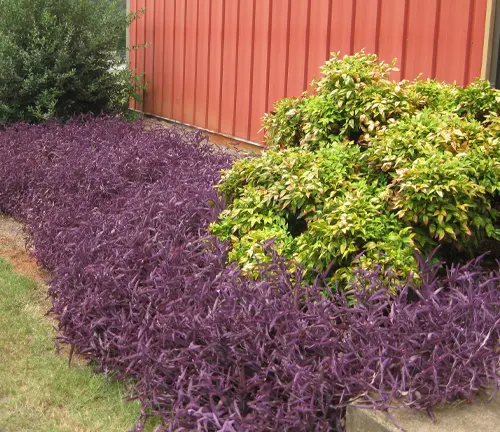
Fragrance
Though not known for its fragrance, the Purple Heart plant compensates with its visual appeal. It’s a feast for the eyes rather than the nose. The lack of fragrance makes it an excellent choice for individuals who prefer their indoor plants to remain unobtrusive in terms of scent.
Soil Stabilization
Beyond its captivating appearance, the Purple Heart plant serves a practical purpose in soil stabilization. Its extensive root system helps prevent erosion and minimizes the loss of topsoil. In landscaping, this attribute is invaluable for preventing soil runoff on slopes and hilly terrains.

Common Uses
The Purple Heart plant has a myriad of common uses, thanks to its adaptability. In indoor spaces, it’s a popular choice for adorning homes and offices. It thrives in hanging baskets, window boxes, and as a tabletop decoration. Outdoors, it works wonders as ground cover and can be used to add vibrant splashes of color to gardens and landscapes.
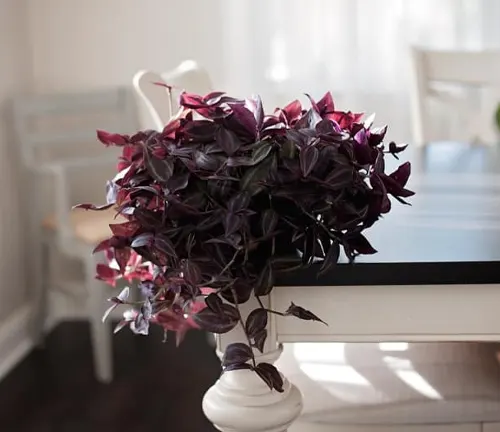
Benefits
Besides its aesthetic allure, the Purple Heart plant offers numerous benefits. It’s known for its air-purifying qualities, helping to improve indoor air quality. This makes it an excellent choice for homes and workspaces. Its low maintenance requirements, including tolerance for neglect and drought, make it an ideal plant for busy individuals or those new to gardening. As a touch of nature within our living spaces, the Purple Heart plant provides a calming and soothing presence, enhancing our well-being and connection to the natural world.
Different Species
Tradescantia pallida
This is the most commonly recognized species of Purple Heart plant. It has vibrant purple leaves and is often used as an ornamental houseplant or outdoor ground cover.
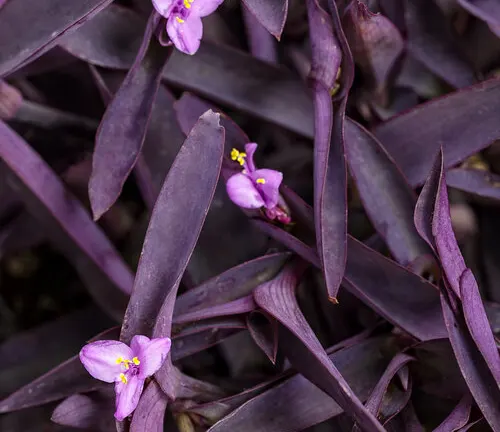
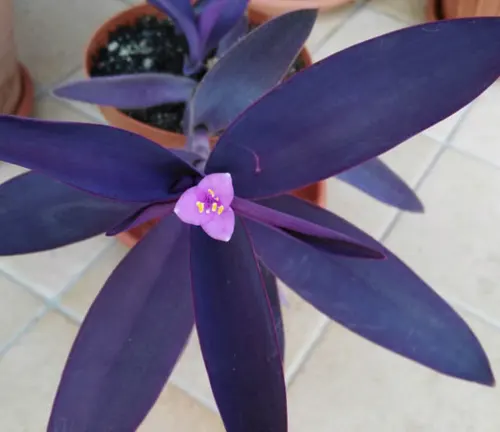
Tradescantia pallida ‘Purpurea’
This is a cultivar of Tradescantia pallida with particularly deep purple leaves. It’s known for its striking color and is a popular choice for indoor and outdoor landscaping.
Setcreasea pallida
Another name for Tradescantia pallida, this species is sometimes referred to as Setcreasea pallida. It features the same striking purple foliage.

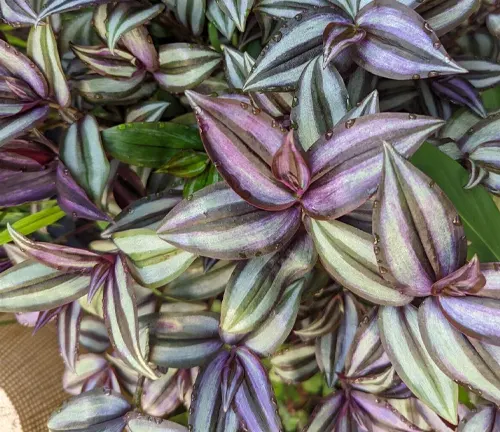
Tradescantia zebrina
While not entirely purple, this plant, commonly known as the Wandering Jew or Inch Plant, has purplish undersides of its leaves with stripes on top. It’s closely related to the Purple Heart plants and is often grown as a trailing houseplant.
Tradescantia ‘Nanouk’
This cultivar is a hybrid between Tradescantia albiflora and Tradescantia sillamontana. It has pink and purple variegated leaves and is prized for its unique coloration.
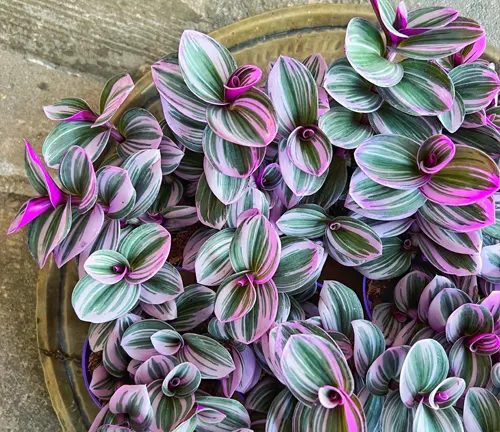
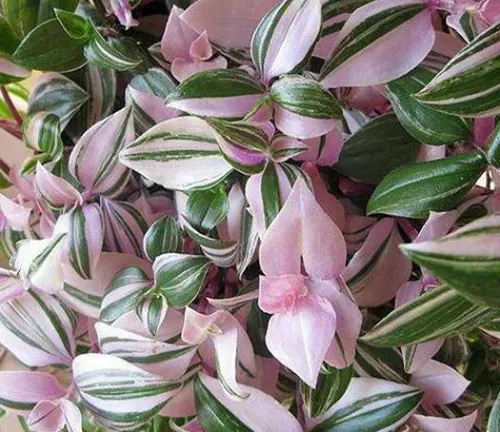
Tradescantia fluminensis
Also known as the Small-Leaf Spiderwort, this species has green leaves with purple undersides and is often used as a trailing houseplant.
Setcreasea pallida ‘Variegata’
This cultivar of Setcreasea pallida has variegated green and white foliage with hints of purple. It’s a visually appealing variety of the Purple Heart plant.
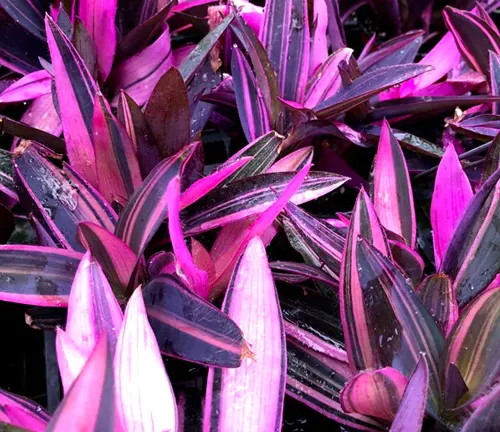
Frequently Asked Questions (FAQs)
- What is a Purple Heart plant?
A Purple Heart plant, scientifically known as Tradescantia pallida or Setcreasea pallida, is a striking perennial plant renowned for its distinctive purple foliage. - How do I care for a Purple Heart plant indoors?
Provide bright, indirect light, water when the top inch of soil is dry, and maintain average room humidity. Regularly trim to control growth and fertilize during the growing season. - Can I grow Purple Heart plants outdoors?
Yes, Purple Heart plants can thrive outdoors in warm climates. They make excellent ground cover or can be grown in hanging baskets. - Are Purple Heart plants toxic to pets?
While not highly toxic, Purple Heart plants can cause mild irritation if ingested by pets. It’s best to keep them out of reach of animals. - How can I propagate Purple Heart plants?Propagation is easy through stem cuttings. Simply snip a healthy stem, let it root in water or soil, and you’ll have a new plant.
- Do Purple Heart plants have any special requirements for soil?
Well-draining soil is essential to prevent root rot. A mix of potting soil and perlite or sand works well. - What is the typical size of a mature Purple Heart plant?
They usually reach a height of 6-12 inches (15-30 cm) and can spread or trail up to several feet, depending on the growing conditions. - How often should I fertilize my Purple Heart plant?
Monthly fertilization during the growing season (spring and summer) is generally sufficient to support healthy growth. - Can I overwinter my Purple Heart plant indoors?
Yes, you can bring your outdoor Purple Heart plants indoors during the winter months to protect them from frost. Ensure they get adequate light and reduce watering. - Are there any common pests or diseases that affect Purple Heart plants?
They are relatively resistant to pests and diseases. However, watch out for mealybugs, aphids, and occasional fungal issues in overly damp conditions. - What’s the difference between Tradescantia pallida and Setcreasea pallida?
These are two scientific names for the same plant, with Tradescantia pallida being more commonly used. The terms are often used interchangeably. - Can I use Purple Heart plants for soil erosion control in my garden?
Yes, Purple Heart plants with their extensive root systems can help stabilize soil and prevent erosion on slopes and hilly terrain.




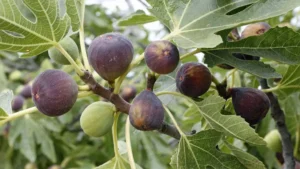

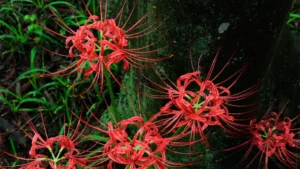

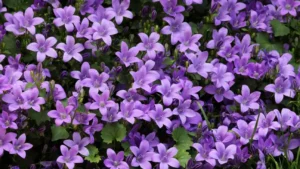
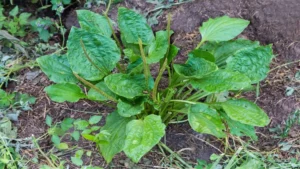

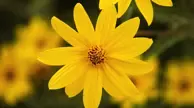

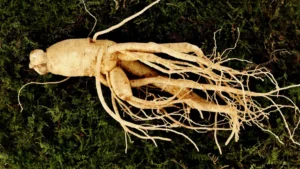
Leave your comment